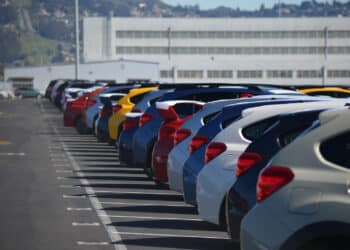5 Mobility Trends Set to Transform Powersports
From autonomous vehicle development to the rideshare revolution, mobility trends have certainly penetrated the car market, and are on the way to changing the auto financing model, too.
But, how are these trends poised to transform powersports?
Even though many of the trends will not be immediate, the industry should be prepared. Here are some of the latest mobility developments, set to transform the space:
@Can Stock Photo / naumoid
1. Peer-to-Peer Vehicle-Sharing
Companies like Getaround and Maven have taken the charge in the carsharing revolution, and now motorcycle and recreational vehicle-sharing is starting to gain ground.
Riders Share, for example, is a peer-to-peer motorcycle rental company that launched in 2016, and has over 450 motorcycles available for rent on the site. The startup made $20,000 in total transactions for 2017. The motorcycle owner sets the daily rental price for their listing, Riders Share takes a 30% cut, and charges a $20 transaction fee.
“There are hundreds of thousands of motorcycles just sitting there doing nothing that could be put to good use,” co-founder Guillermo Cornejo told Powersports Finance. “There are customers that would love to be able to test drive those motorcycles for hours. … What we offer enables dealers to give rentals that are basically a prolonged test drive with no risk to them and with no investment.”
Additionally, vehicle-sharing has caught on in the RV space with companies like Outdoorsy and RVshare. San Francisco-based Outdoorsy, a peer-to-peer RV marketplace, allows individuals to rent out their RVs to other consumers when the vehicles are not in use.
“[RVs are an] idle asset, under-used, very expensive, and hard to sell,” co-founder Jeff Cavins told Powersports Finance. “Most users find themselves upside-down in equity, and most people stop using them after a year or two.”
Offering a similar model is RVshare, which was founded in 2013. The company serves more than 60,000 RV owners across the nation.
2. Machine Learning
© Can Stock Photo / Photonphoto
While many manufacturers have been using machine learning techniques for autonomous vehicle development, the technology is now making its way into the financial space as several auto lenders like Global Lending Services and Ford Motor Credit Co. utilize it for credit decisioning.
Machine learning — a form of artificial intelligence that allows technology to learn without manual input — is now being used in powersports. MotoLease LLC, for example, improved the accuracy of its internal credit forecasting model called M-Score 2.0 in January by using machine learning techniques and alternative data, according to a document shared with Powersports Finance. M-Score 2.0 uses machine learning to “better predict the performance of new lease originations using traditional and enriched alternative data,” according to the document.
Additionally, ZestFinance, an artificial intelligence-based underwriting company, plans to make its foray into powersports with the addition of two potential lender partners, Chief of Staff Kareem Saleh told Powersports Finance. ZestFinance applies big data and machine learning to credit underwriting.
3. Electric Bikes
Project LiveWire / Photo by Harley-Davidson Inc.
Self-driving and electric cars weren’t the only vehicles on display at the Consumer Electronics Show (CES), there were also new innovative motorcycles and scooters.
Yamaha Motor Co., for example, revealed two motorcycle concepts. MOTOROiD is the OEM’s artificial intelligence enabled, self-driving, electric concept motorcycle that uses technology developed by Yamaha to stabilize two-wheeled vehicles and drive autonomously. The AI features can also “recognize its rider’s biometrics” and accept hand gesture commands to start and stop.
Additionally, Harley-Davidson Inc. will “invest more aggressively” in the electric vehicle market, starting with the launch of its first electric motorcycle within the next 18 months, the OEM announced in a fourth-quarter earnings call.
“One key opportunity is the rapidly evolving electric vehicle landscape,” Matt Levatich, Harley’s president and chief executive, said on the call. “The EV market is in its infancy today, and we believe it will drive excitement into our sport globally in both traditional and nontraditional spaces.”
Harley-Davidson announced last week that it has made an equity investment in Alta Motors, an innovator in lightweight electric vehicles. The two companies will collaborate on electric motorcycle technology and new product development.
However, uncertainty remains around the financing and value retention of these innovative bikes.
“My data is so sparse on [electric bikes] that I haven’t been able to draw any conclusions,” Scott Yarbrough, motorcycle editor at Black Book, told Powersports Finance last month. “I haven’t had enough of these bikes rolling through the auctions for long enough, in volumes high enough to get a great sense.”
It will take another three to five years of consumer testing to determine how well batteries hold up and if their maintenance is more minimal than combustion engines, Yarbrough added.
4. On-Demand Rides and Motorcycle Taxis
While not currently operating these programs in the U.S. yet, companies like Uber and Go-Jek are offering on-demand motorcycle taxi services.
The company that brought consumers UberCHOPPER (on demand helicopter rides) and UberSupercars (Lamborghinis, Ferraris, etc.) added a motorcycle service – UberMOTO — in Bangkok to its roster in February 2016. The service was launched to speed up customers’ travels through the city’s severe traffic congestion. UberMOTO operates just like the company’s car services, enabling customers to save money and time with a shorter ride on a motorcycle.
5. Autonomous Vehicles
Photo via Yamaha
While it remains to be seen how self-driving vehicles will truly transform public roads, many experts claim the vehicles will make the roads safer.
“What I think is going to happen is in the next five years, self-driving cars are going to make the roads so much safer for motorcycle riders that we’re going to see another positive cycle,” Riders Share’s Cornejo told Powersports Finance.
Self-driving vehicles are not only set to transform the auto industry but powersports as well, as some manufacturers test the waters with the autonomous technology.
Yamaha Motor Research & Development, for example, debuted a video last September showing off a fully autonomous Viking VI. The video shows the vehicle driving quickly over rugged terrain, and Yamaha said that it is developing “intelligent vehicle technology” in wilderness environments.
The Yamaha Viking VI (AS-X1) will be fully autonomous and include a custom drive-by-wire system, navigation sensors like lidar, point-to-point navigation demonstrated on the off-road test course, and the ability to avoid obstacles such as downed branches.



















